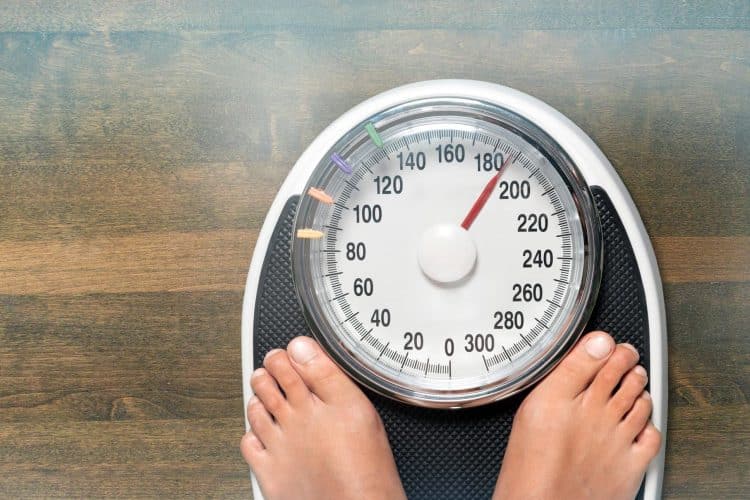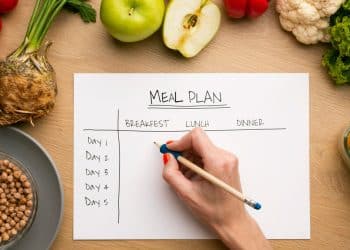A calorie deficit is considered too much if it consistently exceeds 500-1,000 calories per day, leads to weight loss of more than 2 pounds weekly, or prevents you from meeting your essential macro and micronutrient goals.
For most, ‘fitness’ means weight loss.
However, most people give up their fitness ambitions before achieving their weight loss objectives. This isn’t because these folks aren’t doing enough. It is usually because they are doing too much.
As a personal trainer with over seven years of hands-on experience, I have observed that most people adopt an overly restrictive diet while trying to lose weight.
While it might come as a shock to some, cutting too many calories from your diet can also lead to a weight loss plateau. Not only that, but it can also lead to low energy levels and poor metabolism, loss of muscle mass, and other chronic health conditions, which can hamper your longevity.
Calorie Deficit — Introduction

Level Up Your Fitness: Join our 💪 strong community in Fitness Volt Newsletter. Get daily inspiration, expert-backed workouts, nutrition tips, the latest in strength sports, and the support you need to reach your goals. Subscribe for free!
Before we get to what a calorie deficit is, let’s decode calories.
Calories are a measure of energy. The foods and beverages you consume all contain a particular amount of calories. Your body burns calories as fuel to power your daily activities.
Weight loss ultimately boils down to entering a calorie deficit, meaning you must expend more calories in a day than you consume.
Eat more calories than you shed (calorie surplus), and you will gain weight. Conversely, burning roughly the same amount of calories as you eat will keep you at the same weight.
There’s a fine line between a healthy calorie deficit and going overboard. You must learn to recognize when you’ve pushed too far. Some of the most common signs of an extreme calorie deficit include constant hunger and fatigue, irritability, and stalled weight loss.
Why Do People Enter an Extreme Calorie Deficit?
Now, the next logical question is: If an extreme calorie deficit is so counterproductive, why do people take that route?
I’m glad you asked.
Weight loss typically doesn’t follow a linear progression. You might lose some weight, then hit a plateau or regain the lost weight before continuing the weight loss progress.
These weight fluctuations happen because our bodies try to regain the body mass lost to survive. This phenomenon, known as metabolic adaptation (adaptive thermogenesis), is a process through which the body adjusts its metabolism in response to what you eat. (1)
Some get cold feet during the metabolic adaptation process and think they aren’t doing enough.
These folks then end up doubling down on their calorie deficit to get the weighing scale to budge. On the other hand, beginners who don’t know much about a calorie deficit might end up cutting more calories from their diets than necessary.
Newbies should work with a registered nutritionist to develop a personalized diet program that fits their lifestyle. This will cost some money upfront but will save a lot of wasted time and effort in the long term.
According to the Centers for Disease Control and Prevention (CDC), you can safely lose 1 to 2 pounds weekly by cutting 500 to 1,000 calories from your diet daily. (2)
Risks of Cutting Too Many Calories
Now that you know cutting too many calories is a real threat, let’s discuss its effects on your body. Understanding these effects is vital to losing weight sustainably and keeping it off.
Here are the mechanisms you should be aware of:
Metabolic Slowdown
Think of metabolism slowdown as your body’s natural emergency brakes. Your metabolism is what helps you burn calories throughout the day, even when you are not physically active.
When you enter a giant calorie deficit, your body goes into panic mode, as it cannot differentiate between a deliberate dieting program and a famine. In response, your body significantly lowers its metabolic rate to save calories — its most valuable energy source.
A significant metabolic drop can also impair your normal hormonal function, which could increase your body fat stores.
Maintaining a high metabolic rate can help maximize fat loss. (3)
Eating a high-protein diet, drinking green tea, eating spicy foods, and lifting weights are a few effective ways to boost your metabolism.
Nutrient Deficiencies
Cutting too many calories from your diet, especially when you have no idea what you’re doing, increases the risk of micronutrient deficiencies. Here are some of the most common mineral deficiencies dieters run into:
- Iron: This can cause chronic fatigue and hamper your physical performance.
- Calcium: It is crucial for strong bones. Plus, it can boost fat metabolism.
- Zinc: It supports healthy thyroid function, which is a key metabolism regulator.
- Magnesium: This is a superfood that is slowly but surely gaining traction. It can improve your sleep, increase stress tolerance, and reduce the risk of muscle cramps.
Muscle Loss
When you are well-fed, your body uses stored glycogen to burn as fuel. However, when you are starving and out of glycogen reserves, your body breaks down and burns muscle tissue for energy.
This is a double whammy. First, you lose your hard-earned muscle. Also, muscle mass is more metabolically active than fat mass, which helps burn more fat at rest throughout the day.
Less muscle mass will lead to a slower metabolism and increase the odds of regaining lost weight.
Increased Hunger and Cravings
In an extreme calorie deficit, your hormones work against you.
Your body increases the production of the hormone ghrelin, popularly known as the hunger hormone. On the flip side, it lowers leptin production, the hormone that signals fullness to your brain.
This is the reason many people end up feasting on junk food on breaking a fast or after coming off an extreme weight loss diet.
Recognizing the Signs of an Excessive Calorie Deficit
More isn’t always better, especially when running a calorie deficit.
However, most people don’t realize they are overdoing a calorie deficit until it is a little too late. Here is how to determine if you’re pushing it too hard:
Level Up Your Fitness: Join our 💪 strong community in Fitness Volt Newsletter. Get daily inspiration, expert-backed workouts, nutrition tips, the latest in strength sports, and the support you need to reach your goals. Subscribe for free!
Constant Fatigue and Weakness
Cutting 500 to 1,000 calories from your diet might feel a little challenging, especially at the beginning, but it won’t cause chronic fatigue or weakness. If you feel like you are always dragging your feet throughout the day, it is time to reassess your calorie deficit.
Mood Fluctuations
Have you been flipping out on small things lately? Chances are an extreme calorie deficit is to blame here. Feeling low or having difficulty concentrating are other common signs that you’ve cut out way too many calories from your diet.
Hair Loss
This is one dieting side effect that no weight loss guru will ever tell you. Nutrient shortages often lead to hair fall. You might also notice dandruff or a change in your hair texture. Look at your pillow each morning to ensure your body is adjusting well to your calorie deficit.
Excessive Cravings
As mentioned earlier, cutting too many calories from your diet can cause hormonal fluctuation, which can lead to cravings, often at odd hours. If you can’t stop thinking about food, even when you are full, it is a sign that your body needs more energy.
Compromised Immune Function
Many people tend to fall sick while trying to lose weight. This points to an overstressed immune system due to a lack of micronutrients. If you’re getting sick consistently or it is taking you too long to recover from an illness, you should consult your doctor.
Pro Tip: While making any changes to your diet, it is incredibly important to track all your health metrics.
Determining Your Ideal Calorie Deficit
There is only one way to avoid an extreme calorie deficit: Determine your unique calorie requirements and design a balanced diet around it.
The ideal calorie intake for each individual will vary depending on multiple factors, including age, height, gender, genetics, weight, metabolic rate, fitness, and activity levels. This is one reason why following a vanilla diet plan you find online isn’t going to work for you.
Here are the things you must consider when calculating your ideal calorie intake (and deficit):
BMR
Basal Metabolic Rate (BMR), also known as resting energy expenditure (REE), refers to the minimum number of calories required daily for basic life-sustaining bodily functions like breathing, digestion, and growing hair and nails while at rest.
Find out your BMR using this online calculator.
TDEE
Total Daily Energy Expenditure (TDEE) involves the total number of calories your body needs throughout the day to function optimally. TDEE comprises BMR plus the energy you burn while performing different physical activities.
Determine your TDEE here.
Finding Your Ideal Calorie Deficit
Remember, starting with a small calorie deficit is always better than going extreme.
I recommend that my clients begin by cutting 500 calories from their TDEE. Ensure that these calories are mostly from carbs and fats. Since protein is more metabolically active, it can help burn fat throughout the day.
Give your new diet at least two to three weeks to work its magic.
Stick with the new calorie target if the weighting scale’s needle is budging in the right direction. On the other hand, you can bump up the calorie deficit if you do not see desirable results.
Subsequent calorie cuts must be small and gradual. Avoid going from cutting 500 calories to 1,000 calories. If you don’t see the result after trimming 500 calories, transition to a 700-calorie cut before moving onto 800-900 and then 1,000.
This will also ensure you stay within the CDC’s calorie deficit recommendations. Cutting 500-1,000 calories from your diet can result in a 1-2 pound weekly weight drop.
An Alternate Approach To Cutting Calories
This is a more hands-on approach.
It involves tracking your daily calorie intake for at least a week using apps like MyFitnessPal. You must then cut 500 calories from your average daily calorie intake. Many people find this approach works better for them as it gives them accurate data based on their lifestyle.
Pro Tip: Learn to listen to your body. You might be too hard on yourself if you’re constantly exhausted or cranky. Pull back on the calorie deficit until you feel better.
Ways to Achieve a Healthy Calorie Deficit
Now that you know the number of calories you should be cutting from your daily diet to lose fat, here is how to achieve it without losing muscle or feeling drained:
Eat Whole Foods
Your diet should primarily consist of nutrient-dense whole foods like fruits, nuts, vegetables, and lean proteins, such as chicken and fish. These will keep you feeling full for longer and avoid the possibility of feeding on junk foods.
Lift Weight
Resistance training is often overlooked in a weight loss program. Pumping iron can help build lean muscle tissue, which is more metabolically active than body fat. It also gives you a more aesthetically appealing physique, which is always a welcome benefit.
Listen To Your Body
A weight loss diet program usually has strict rules about what and when to eat. While restricting yourself is necessary to lose weight, it shouldn’t lead to deprivation. Developing a negative relationship with food never ends well.
Stress Less
Chronic stress can elevate cortisol levels, which can hinder fat loss progress. Let’s be practical: Eliminating stress from your life isn’t possible. However, you can minimize it by taking long walks, meditating, journaling, and reading. If these techniques don’t work, I suggest seeking counseling.
Sleep Well
Your body recovers during sleep. It is also essential for regulating hormones that control hunger and metabolism. You must sleep at least seven to eight hours each night to give your body ample time to recuperate.
Hydrate
The human body is 70 percent water. Drinking water at regular intervals throughout the day can help keep you satiated and reduce the risk of eating junk food. Drink at least a gallon of water daily.
People dealing with health issues must always consult a healthcare professional before starting a new diet or training program.
When to Seek Professional Help
Entering a calorie deficit to lose weight can be challenging. Here is when you should seek professional help:
- Spotted a Warning Sign: If you feel that you are developing an unhealthy relationship with food or dealing with an eating disorder, it might be time to cut short your weight loss program and consult your healthcare provider.
- No Results: There are so many variables that contribute to weight loss. Folks who are stuck on a plateau even after adjusting their diet and training multiple times should see a professional.
- Mental Fog: If the calorie deficit is causing a loss of concentration or motivation, you should speak to a nutritionist.
Conclusion
Cutting out more than 1,000 calories from your daily diet is too extreme in most cases. Per the CDC, cutting 1,000 calories a day will help you safely shed 2 pounds weekly. Remember, consistency is key to a successful weight cut.
Drastic weight loss measures increase the risk of developing chronic health conditions. Make gradual and sustainable calorie cuts from your diet to experience long-term weight loss benefits. A balanced diet, combined with a personalized training and recovery program, is the most effective way of losing weight.
If you have any questions about a calorie deficit, drop them in the comments below, and I’ll be happy to help!
References
- Martínez-Gómez, M. G., & Roberts, B. M. (2022). Metabolic Adaptations to Weight Loss: A Brief Review. Journal of strength and conditioning research, 36(10), 2970–2981. https://doi.org/10.1519/JSC.0000000000003991
- Centers for Disease Control and Prevention (CDC). (2024, March 15). Losing Weight. Retrieved from https://www.cdc.gov/healthyweight/losing_weight/
- Molé P. A. (1990). Impact of energy intake and exercise on resting metabolic rate. Sports medicine (Auckland, N.Z.), 10(2), 72–87. https://doi.org/10.2165/00007256-199010020-00002















